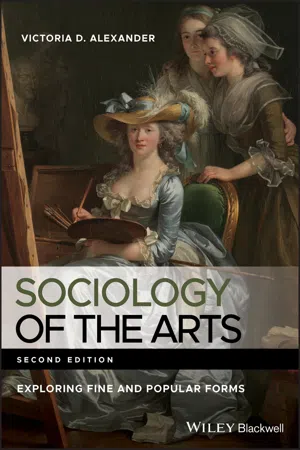
Sociology of the Arts
Exploring Fine and Popular Forms
Victoria D. Alexander
- English
- ePUB (mobile friendly)
- Available on iOS & Android
Sociology of the Arts
Exploring Fine and Popular Forms
Victoria D. Alexander
About This Book
Explains the key concepts, theories, and studies in the sociology of the arts—the fully updated new edition of the classic textbook
Sociology of the Arts is a comprehensive yet accessible review of sociological approaches to studying the fine, popular, and folk arts. Integrating scholarly literature, theoretical models, and empirical studies, this authoritative textbook provides balanced coverage of a broad range of essential topics—enabling a deeper understanding of the field as a whole. Throughout the text, numerous real-world case studies reinforce key concepts, stimulate classroom discussion, and encourage students to contemplate abstract theoretical issues central to the relationship between art and society.
Now in its second edition, this bestselling volume features fully revised content that reflects the most recent literature and research in the field. New discussion on the production and the consumption of culture are complemented by fresh perspectives on changes in the social world such as the rise of the internet and digital media. Updated chapters offer insights into social boundaries and embodiment in the arts, emplacement, materiality, the social construction of art and aesthetics, and more. Exploring how art is created, distributed, received, and consumed, this textbook:
- Explores both classic work and new approaches in the sociology of the arts
- Features case studies and discussion questions on art forms including popular music, film, romance novels, visual arts, and classical music
- Discusses the meaning of artistic objects and why interpretations of art vary
- Examines the ways art intersects with race, gender, sexuality, and class
- Includes photographs, tables and figures, and a comprehensive reference list
Written by a leading scholar in the field, Sociology of the Arts: Exploring Fine and Popular Forms, Second Edition is an ideal textbook for advanced undergraduate and graduate courses on sociology of art and culture, media studies, anthropology of art, arts management, and the social history of art, and is a useful reference for established scholars studying any aspect of sociology of the arts.
Frequently asked questions
Information
1
Introduction: What is Art?
Defining Art
Like other complex concepts, [the concept of art] disguises a generalization about the nature of reality. When we try to define it, we find many anomalous cases, cases which meet some, but not all, of the criteria implied or expressed by the concept. When we say “art,” we usually mean something like this: a work which has aesthetic value, however that is defined; a work justified by a coherent and defensible aesthetic; a work displayed in the appropriate places (hung in museums, played at concerts). In many instances, however, works have some, but not all, of these attributes. (p. 138)
- There is an artistic product. It may be tangible, visible, or audible. The product can be a physical object, like a book or record. Or it can be a performance, like a play or a concert.
- It communicates publicly. To be art, the cultural product must not only exist, it must be seen, heard, touched, or experienced by an audience, either in public or private settings. All art is communication. Of course, not all communication is art.
- It is experienced for enjoyment. “Enjoyment” can take many forms. Art might be consumed for aesthetic pleasure, for sociability and fun, for mental stimulation, or for escape. Sometimes, however, people are exposed to art because “it’s good for them,” as in a school trip to a museum.
- Art is an expressive form. When art relates to real life, it presents a fiction or an interpretation. Sometimes art claims to tell the “truth,” but if it takes this idea too literally, it moves into the area of documentary, non‐fiction, or news.
- Art is defined by its context, both physical and social. What is art in a museum or theater may be just odd objects or strange behavior in other settings. When different social groups view the same expressive product, they may disagree on whether or not it is art.
Table of contents
- Cover
- Table of Contents
- Title Page
- Copyright Page
- List of Illustrations
- List of Tables
- List of Figures
- List of Boxes
- Preface and Acknowledgements
- 1 Introduction: What is Art?
- Part I: The Relationship between Art and Society
- Part IIA: The Cultural Diamond The Production of Culture
- Part IIB: The Cultural Diamond The Consumption of Culture
- Part III: Art in Society
- Part IV: Conclusion
- References
- Index
- End User License Agreement